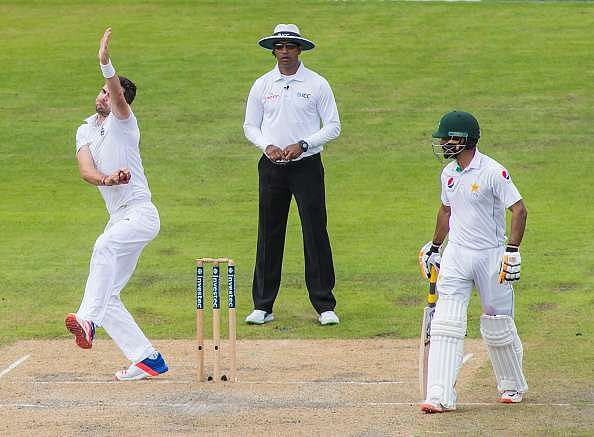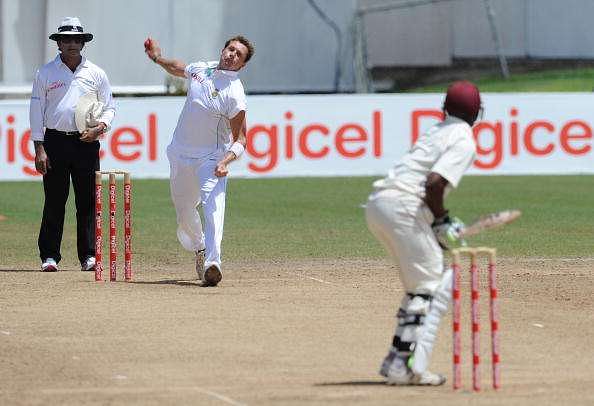
To bowl from close to the stumps or wide of the crease - an analysis from a fast bowler's perspective
Cool, cloudy mornings at Nottingham are usually associated with gloom and a certain degree of lethargy by the dwellers of the city. The notoriously unpredictable English weather has no fans among the British, although for a foreigner, the fickleness of the climate offers the much-needed refreshment from the planned – often boring – lifestyle in the country.
It was on one such morning in 2008 that a certain young man in whites enthralled those present at Trent Bridge to witness the third Test between England and New Zealand. Cricket followers were not new to James Anderson, but never before had they witnessed such exceptional display of outswing from the man right from the start.
On the ninth ball of New Zealand’s innings, charging in from over the wicket, Anderson released the ball wide, directed it immaculately at the batsman’s toes, and let the cherry do the rest. An unsuspecting Aaron Redmond poked hesitantly as the ball moved away sharply at the last moment, taking the off-stump along with it.
Four overs later, Brendon McCullum survived a scare as he swung wildly at an orthodox outswinger. Next ball, Anderson went slightly wider of the crease and released the ball almost in the same fashion that dismissed Redmond earlier. The Duke rattled McCullum’s off-stump and reduced England to 14/2 in just 5.4 overs.
Anderson recorded 7/43 in that innings, bowling a stump-to-stump line at left-handers and preferring to go a bit wider for right-handers.
The England international is one of the finest exponents of swing bowling in modern day cricket, and the major reason behind his success is his wonderful understanding of the virtues of bowling from close to the stumps as well as from wide of the crease.
The benefits of sticking close to the wicket
As a trainee, one of the first cricket lessons impressed upon us by the coach is to learn to bowl from close to the stumps. On delving deeper into the issue, the idea appears to be a well-founded one.
Bowling from close to the stumps not only ensures a straighter trajectory, thereby making it easier to aim at the fourth stump line, but also makes life difficult for batsmen who aren’t aware of their off-stump. Under conditions conducive to swing bowling, a well-pitched delivery rising along the line just outside the off-stump – aptly called the corridor of uncertainty – can swing away or into the batsman or may even hold its line on occasions.
This lands the bearer of the willow in a fix – he might succumb to an outside edge if he plays for the inswing or might be trapped leg before if he plays for the outswing. Moreover, there’s the possibility of the menacing inswinger to find its way in between the bat and pad and onto the stumps.
Medium pacers like Bhuvneshwar Kumar who can swing the ball both ways prefer this approach, for it always leaves the batsman thinking. A minor advantage of bowling from close to the stumps may be the extra yard of pace that emerges due to the shorter path travelled by the ball in contrast to one hurled from wider of the crease, but that seems to be more theoretical than practical, and hence negligible.
Choking the batsmen and building pressure
But what if there’s no swing on offer? It is here that the stump-to-stump line yields high dividends as opposed to an angled approach.
Pitching the ball consistently around the off-stump on a good length or mildly back of a length provides the opportunity to generate an extra bit of bounce that more often than not results in awkward edges to the wicketkeeper and the slips. Mohammad Shami’s exploits at Antigua in the recently concluded Test is a case in point.
Also, there’s less chance of leaking runs once the bowler decides to hold on to the nagging line. Like Glenn McGrath who preferred bowling from close to the stumps, South African bowler Shaun Pollock too bowled almost exclusively stump to stump. No wonder, he averaged under 21 in his first 78 Tests before ending up with 421 scalps at a miserly rate of 23.10 apiece.
But then, just like everything else in life, this too has its own cons. As Steven Finn found out to his displeasure in 2012-13, the habit of running in too close to the wicket may result in dislodging the bails on more than one occasion. The rule now in place states that a no-ball will be called when a bowler breaks the non-striker’s end stumps in his delivery stride. The trick, therefore, is to run in close to the stumps but not close enough to disturb the bails.
The riskier but more rewarding route
One of the joys of watching Test cricket is the frequency of oohs and aahs that accompany a premium swing bowler’s deliveries which beat the edges. It takes a great amount of skill to produce sharp aerial movement, but once that is achieved, a new problem surfaces – the ball swings too much to find the edge.
The solution to this problem of plenty, however, is a simple one – a wider approach to the bowling crease. While the ball being released on the line of off-stump and veering away past the 5th stump may seem a treat for the eyes, the truth remains that it does nothing to the wicket tally.
Relocating the starting point of the run-up to a wider position would move the eventual position of the bowler at the crease wider, thereby resulting in an angled delivery towards the batsman. Now, once the outswing comes into play, the ball moves just enough to kiss the top of the off-stump or glide along the corridor.
The appearance of the ball angling into the batsmen almost inevitably invites a forward drive, and as the cherry cuts away late, it induces the edge back to the keeper or the slips. Trent Bridge in 2011 witnessed this lethal strategy from Anderson and Stuart Broad who after beating the bat a number of times initially, altered their alignment to a more mid-crease position and began inducing edges from the batsmen.
The natural angle and its pros
Bowling from round the wicket generates a natural angle, and bowlers try to enhance that effect by choosing to go wide of the crease, especially against a southpaw at the striker’s end. Dale Steyn wrecked havoc against Australia at MCG in 2008 using this technique. He set the left-handers up with outswingers before leaving them befuddled with one that chipped in and destroyed the stumps.
Imran Khan, for instance, had a peculiar manner of delivery. He would stand very wide, assess the field and begin his run up. He would charge in towards the non-striker’s stumps, but never quite manage to get close enough to them, and then move sharply away from the pitch once the ball left his hand.
He would get the ball to reverse on occasions, and the angled approach would turn out to be of assistance, because the more angled the seam is, the more surface area of the rough face is exposed to the air resulting in more turbulence and hence more reverse swing.
The problems with this method
Khan was one-of-a-kind, and it’s rather foolish to attempt to emulate his run-up. While bowling from wide of the crease definitely has its benefits, the probability of veering down the leg onto the pads is elevated, resulting in the ball being worked away for easy runs on the onside. Not only does this release the pressure created hitherto on the batting side, but also makes the bowler lose his rhythm at times.
Further, the likelihood of committing a back-foot no-ball becomes exceptionally high with this position. Courtney Walsh, with his high delivery action from wide of the stumps, forged an immensely successful partnership with Curtly Ambrose, who once leaked as many as nine no-balls in an over while bowling around the wicket and wide of the crease.
The margin of safety reduces appreciably as the delivery point moves horizontally farther from the stumps. The back-foot no-ball is a risk that comes with the exciting prospect of picking up wickets with aerial deviation, and strike bowlers would more often than not back themselves to go for it, irrespective of the repercussions.
That, in essence, is where the thrill of Test cricket lies at the end of the day.

